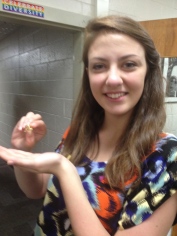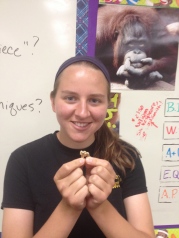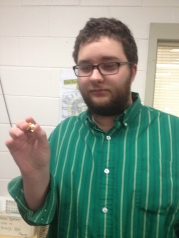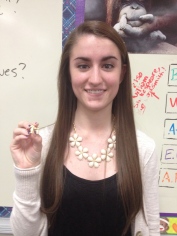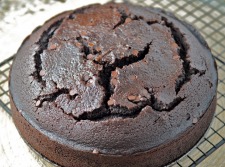If you're a Fel 2.0 loyalist, you may recall that in Fall, I committed to gamification in one of my classes as chronicled in my post Monkey Business: The Gamification of AP English.
The notion of gamification appealed to me because of its potential to engage and motivate students, and to somehow make the difficult process of writing an AP Timed essay fun. Shouldn’t that, after all, be the goal of every educator (and possibly very human being): to make the hard stuff in life fun?
So, I took the toughest part of my Advanced Placement English class and gamified. Each student competed with him/herself to achieve the requisite AP analytical writing skills (one badge for each skill: focusing on the prompt, embedding quotes, providing scholarly commentary, using the vocabulary of literary analysis, and including a substantive closing) in the hopes that this would land them to a good AP exam score, and more importantly it would help them master these critical skills for college and beyond. The golden ape pin (their culminating prize with all 5 badges earned) would be a tangible motivator that would remind them of their writing ability and the growth they made.
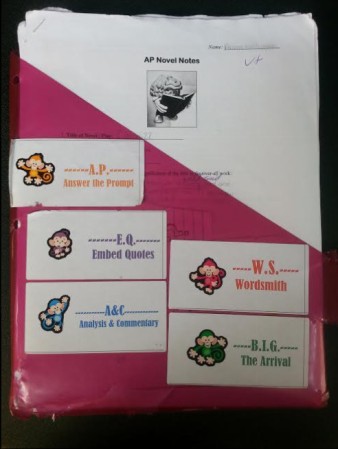
Badge Pride on a Student Binder
So, what happened? After explaining the gamification process and badge skills, we dove right in, and the return of each timed essay found the room teeming with anticipation. Would they get a badge? If not, why not? And what would they have to improve in order to get one?
These simple little stickers were somehow having a profound effect on these high-achieving students. This was arguably childish, perhaps even pathetic, but it seemed to be working. They were clearly tuned into their writing at a level I had not previously seen. They proudly displayed their badges on their binders and folders.
Bottom line results? All of my students received some badges, but only 5 of the 16 received all badges (and the highly-coveted Golden Ape). More on my “take aways” later, but first, theirs:
What They Thought: In an end-of-the-year survey, All but one student reported that we had “the right amount” of focus on the badges or we should have spent even “more time” on them.
Their comments included:
- “The badges helped my by breaking down each category that I needed to focus on in my papers, and helped me to improve in that way.”
- “It helped me think about the components of a good essay, especially the Big Ending one. I feel like almost each essay I wrote was stronger than the last.”
- “Although I didn’t get the golden ape, I found it incredibly useful on focussing myself during essays. It really helped me improve in each of the five important components.”
- “Not only does it make us think of all of the devices that need to be incorporated, but also adds a challenge and ‘competition’ for us to look forward to.”
- “I know I worked harder than I would have just for a grade. I really wanted to get that golden APE, and I’m sure any future apes worth their buttons will likewise.’
- “Having the mini-goals working up to the golden ape was actually very motivating to me and helped me concentrate on all aspects of my papers.”
Not all comments were rainbows and unicorns however, bringing up some critical points for me to consider:
- “It may have strayed me from the real goal a little bit. I really wanted to get all the badges so I would only focus on doing one thing to get a certain one that week when writing an essay, instead of thinking about having all five components in every one.”
- “I prefer focusing on well-rounded essays instead of trying to get a specific badge and missing out on the other components.”
- “It helped me try to incorporate the 5 components, however I think that students should be able to do this without trying to get an award.”
What I thought:
My students were much more motivated to look at specific aspects of their writing and improve them. One of the biggest frustrations in teaching is seeing students make the same mistakes repeatedly without exerting effort to fix them. This was clearly not the case when the process was gamified. Improvement was seen as a logical step in reaching the next level. More students than in any previous year came to conference with me on how they could improve. Students consciously planned what they’d change in their next essay. In this regard, gamification was an unqualified success.
My students were much more motivated to look at specific aspects of their writing and improve them. One of the biggest frustrations in teaching is seeing students make the same mistakes repeatedly without exerting effort to fix them. This was clearly not the case when the process was gamified. Improvement was seen as a logical step in reaching the next level. More students than in any previous year came to conference with me on how they could improve. Students consciously planned what they’d change in their next essay. In this regard, gamification was an unqualified success.
Interestingly, though, when comparing my gamification numbers with the results of the College Board AP English exam, “success” was much more ambiguous. Of the 5 students who received the Golden Ape, demonstrating mastery of each of the timed essay components, 2 of them did not receive a passing score on the College Board AP English exam. Furthermore, none of those who received the top AP English Exam Score of 5 received a Golden Ape in class.
I’ve mulled over these incongruities and I see two different ways to interpret them: 1. My gamification process is not in line with the AP English Exam. I am either measuring the wrong things or evaluating them incorrectly. 2. Those two students who received the Golden APE but did not receive a passing AP exam score either choked on the AP English exam, or their AP Multiple Choice score was so low that even strong essay scores could not bring them up to a passing holistic score.
So my bottom line debrief on year 1: While this experiment clearly succeeded in the areas of student motivation and reflection, there is less clarity in its correlation to AP English exam performance. While I’d prefer that this wasn’t the case (and maybe next year it won’t be) I am comfortable with it.
I have always told my students that a passing score on the AP exam (translating to college credits) is icing on the cake. The true take-away of any class should be learning, self-improvement, and readiness for what the next step in life brings. By that criteria, and from what students said and I observed, I think the gamification process is an imperfect but delicious cake, with or without the icing. So I’ll tweak the recipe, but continue to serve it.

